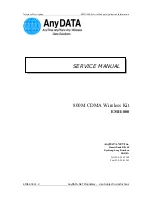
.
Page 6
11/16/01
NavNet CAT5 Cable Installation Steps:
A. Pre-Wire the NavNet Installation with CAT5 or CAT5e Cable. Crimp Male RJ45
Connectors to each end of the CAT5 Cable in a “Straight” Wiring Configuration.
Run CAT5 from each Display or Network Sounder in the NavNet to the location where
the hub will be mounted.
B. Attach a Female-to-Female RJ45 Inline Coupler to the Display or Sounder CAT5
Cable End.
This RJ45 “Straight” Inline Coupler can be purchased at CompUSA or at other
vendors. The Belkin Part Number for this coupler is R6G089-F.
Do NOT use a “Cross-Over” Coupler.
RJ45 Inline Coupler Female/Female
Manufacturer – Belkin Part #R6G089-F
CompUSA SKU #612313
C. Attach One Furuno “Display Adapter Cable” to Each NavNet Display and Network
Sounder. Connect the Adapter Cables to the RJ45 Couplers.
The Furuno Display Adapter Cable is a 0.5m cable with a female 6 pin connector on
one end and a male RJ45 connector on the opposite end.
000-144-601 Display Adapter Cable 0.5m 6P(F)-RJ45(M)
NOTE:
Creating a Watertight connection for the RJ45 coupler junctions is the
responsibility of the installer.
•
CAT5 Cable and RJ45 Connector Information
While a complete explanation on installing CAT5 Network Cabling is beyond the scope
of this bulletin, some important information and excellent Internet resource material is
provided below to glean further knowledge about installing network cabling. These
guidelines must be followed when installing any Furuno NavNet Network Cabling.
CAT5 Cable Installation Notes:
A. Avoid Cable Stretching
– The maximum pulling tension for CAT5 Cabling is 25lbs!
Exceeding this limit may cause permanent damage to the cable. CAT5 Cables utilize
exact twisted pairs for shielding protection. Distortion of the twists in the pairs
caused by excessive pulling could introduce noise problems. Use plenty of “Cable
Lube” when running cables in tight areas.
B. Avoid Tight Bend Radii and NEVER “KINK” CAT5 Cable During Installation
– Over
bending CAT5 cable during installations will damage the cable. Avoid right angles
and do NOT tighten cable ties very tightly. Loose cable ties should be used to secure
CAT5 cabling. Tight cable ties will “Kink” CAT5 Cables. If a “Kink” is made in a CAT5
Cable, it should be replaced.






































